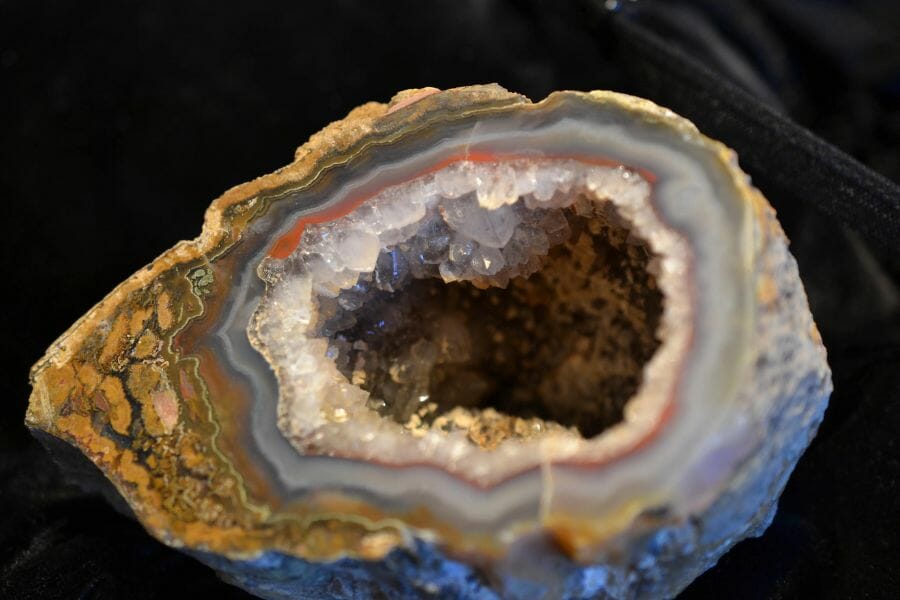Geodes are like nature’s surprise eggs, filled with sparkling crystals inside a plain-looking rock. Our state is a treasure trove for these hidden gems, with its many different landscapes that make it perfect for rock hounds.
If you’re itching to crack open your own crystal-filled wonder, you’re in the right place!
This article will show you the best spots in our state to find geodes. We’ll also share some handy tips to make your geode hunting adventure a success.
So grab your hammer and get ready to discover the beauty hiding in ordinary-looking rocks all around this state!
How Geodes From Here
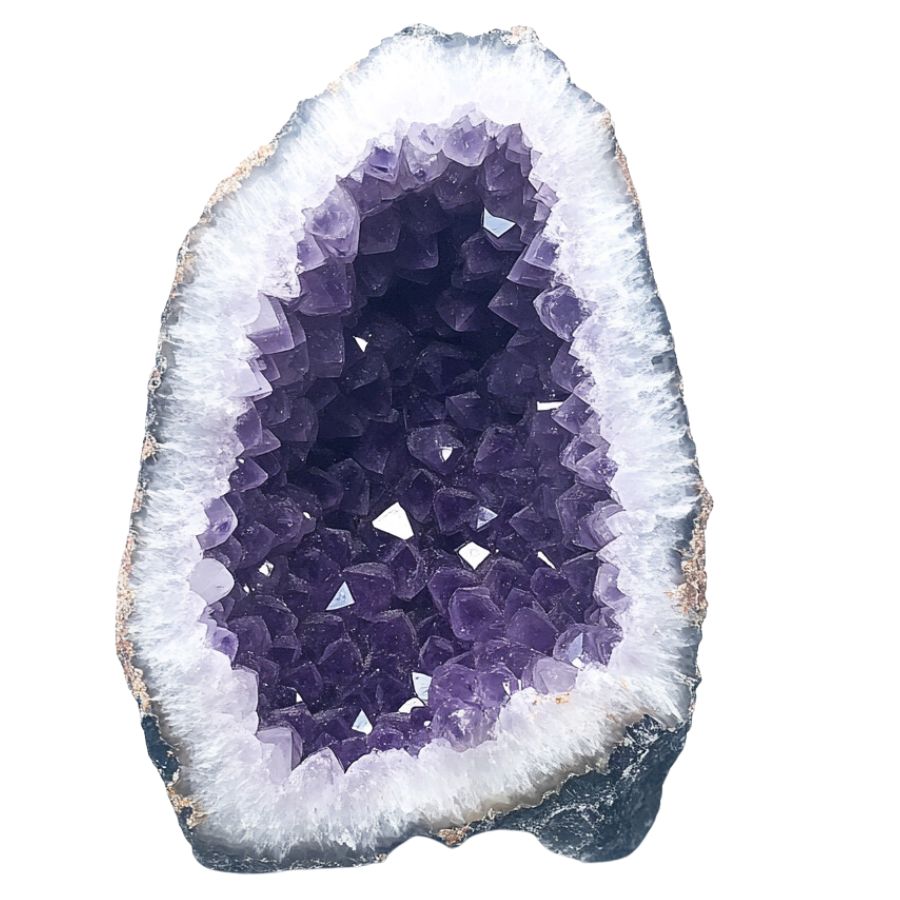
Geodes form when bubbles in volcanic rocks or spaces in sedimentary rocks get filled with minerals over time.
First, water rich in minerals like quartz or calcite seeps into the hollow space. As the water evaporates, it leaves behind the minerals, which slowly build up layer by layer.
Eventually, these minerals create a crystal lining inside the geode. The outer shell stays rough, while the inside becomes a sparkling treasure.
The process can take thousands, even millions, of years, making each geode a unique and beautiful time capsule of Earth’s natural forces.
The Types Of Geodes Found in the US
There are many fascinating varieties of geodes that can be found across the United States, including in our own state. Each type is distinctly beautiful and intriguing:
Amethyst Geode
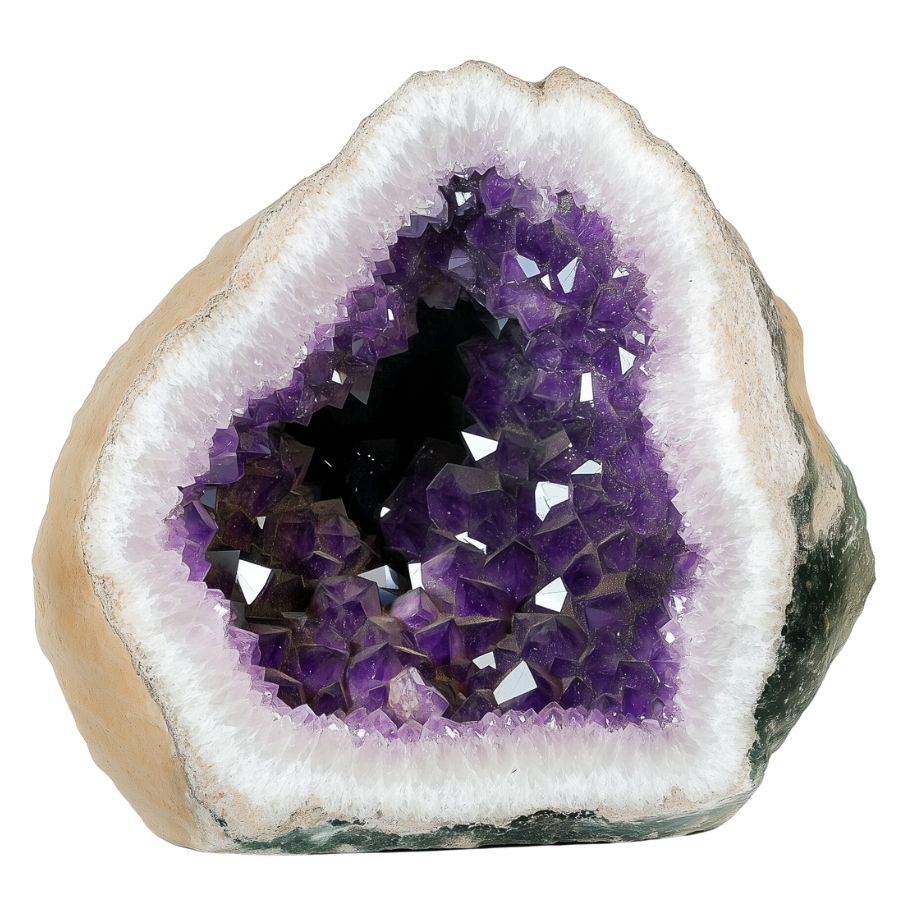
Amethyst geodes look plain on the outside, like a potato. But crack them open, and you’ll find stunning purple crystals. These crystals can be light lavender or deep purple.
The structure of crystals inside can vary widely. Some are tiny and densely packed, creating a sparkling surface. Others form large, distinct points that jut inwards.
The color range is impressive too, from pale lilac to deep royal purple. Some amethyst geodes develop unique features. “Stalactites” of amethyst might hang from the top.
In rare cases, you might find a water bubble trapped inside, a remnant from the geode’s formation millions of years ago.
Citrine Geode
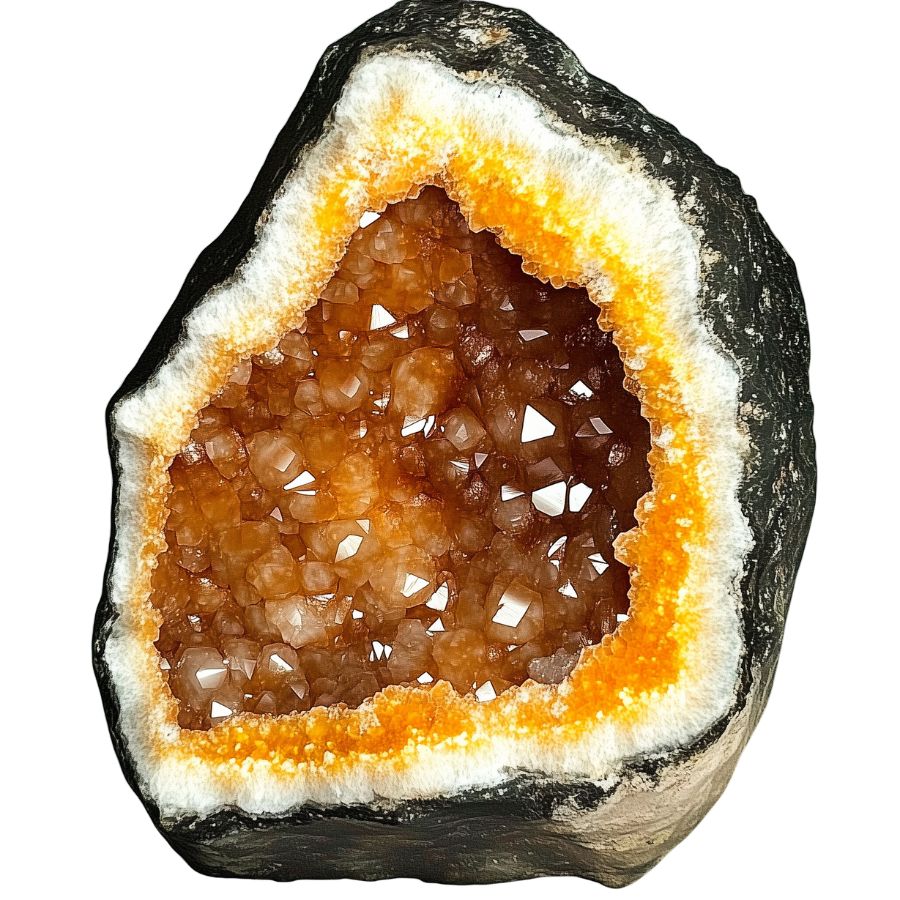
Citrine geodes are eye-catching rocks with golden yellow to orange crystals inside. They sparkle when light hits them, looking like sunshine trapped in stone. The colors come from iron mixed in with the quartz.
Unlike many gemstones, citrine’s color is often evenly distributed throughout the crystal.
Most citrine on the market isn’t natural. It’s actually heat-treated amethyst. This process turns the purple amethyst into vibrant citrine. Natural citrine is rarer and often has a more subtle color.
Pyrite Geode
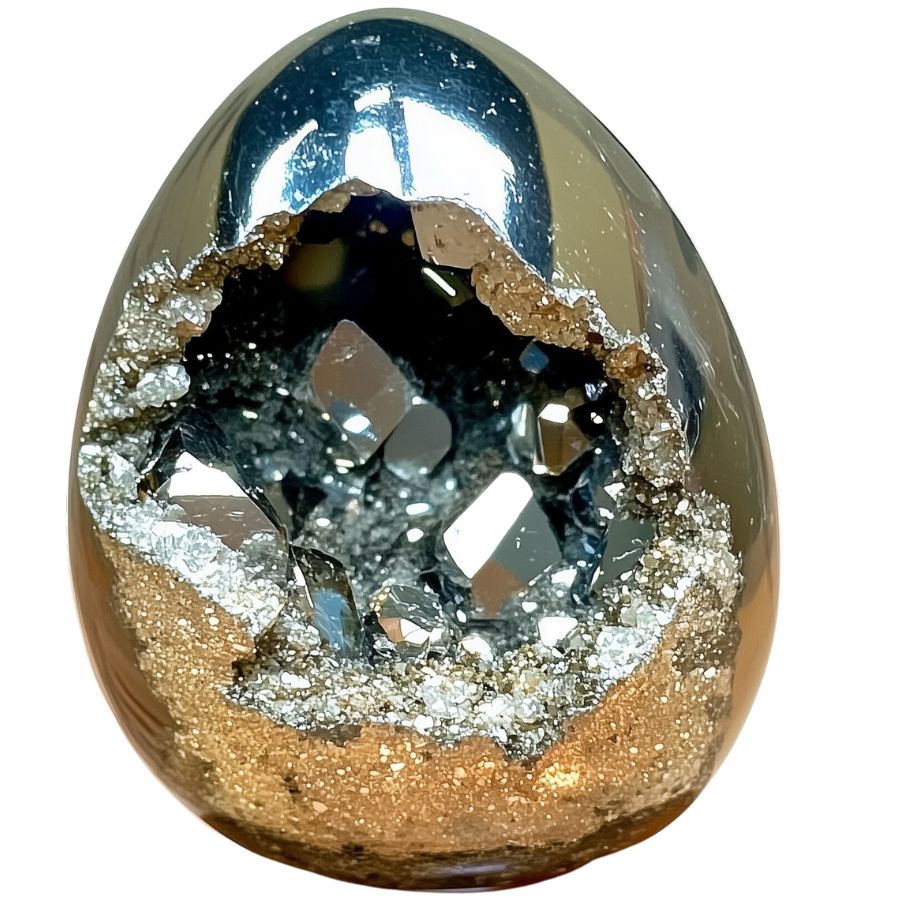
Ever cracked open a rock and found gold inside? Well, not real gold, but something that looks just like it. That’s a pyrite geode. Pyrite is called “fool’s gold” because it’s so shiny and golden.
Inside these geodes, pyrite forms in cool shapes. Sometimes it’s perfect cubes. Other times its clumps or even round balls called “pyrite suns”.
Pyrite has a fun history. People have been mixing it up with real gold for thousands of years. That’s how it got its nickname.
Selenite Geode
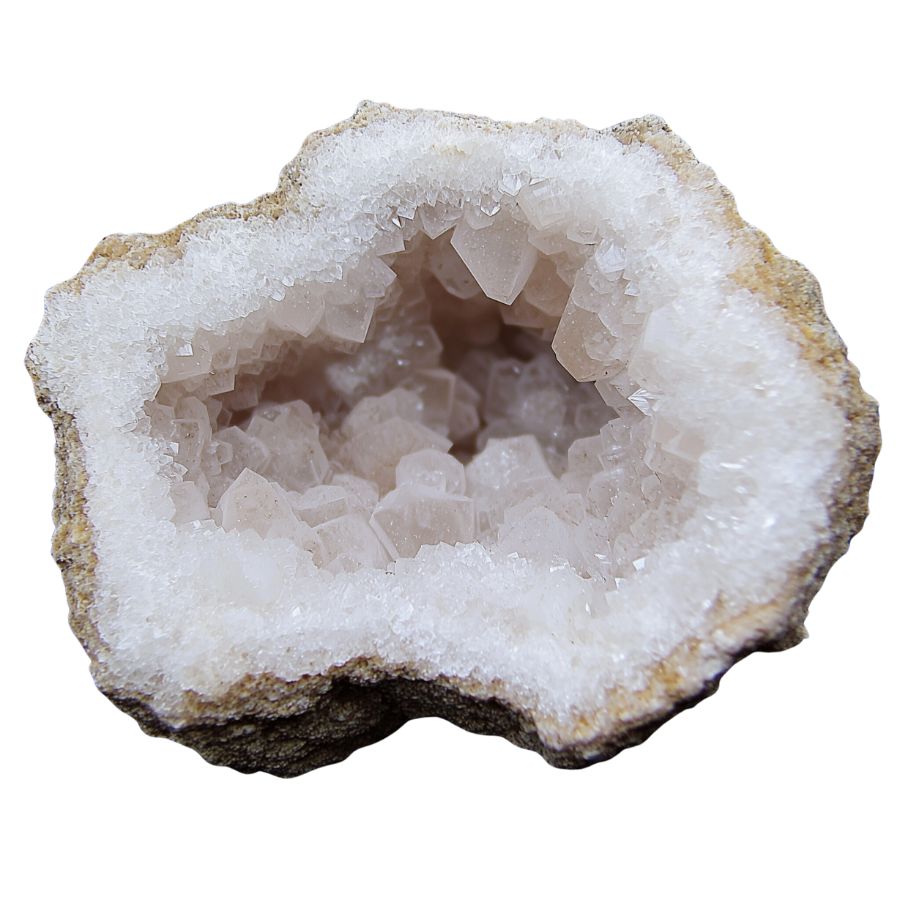
Selenite geodes stand out from the crowd. They’re white and see-through, with a glassy look. When you open one up, you’ll see crystals that look like they’re made of ice or moonlight.
Unlike harder geodes, selenite is soft. You can scratch it with your fingernail! This softness means you need to handle it carefully. But it also means selenite can be shaped into beautiful forms easily.
One cool thing about selenite is how it plays with light. Hold it up to a lamp, and you’ll see the light shine right through it. This makes selenite geodes popular for decorative lamps and light fixtures. They add a magical glow to any room.
Celestite Geode
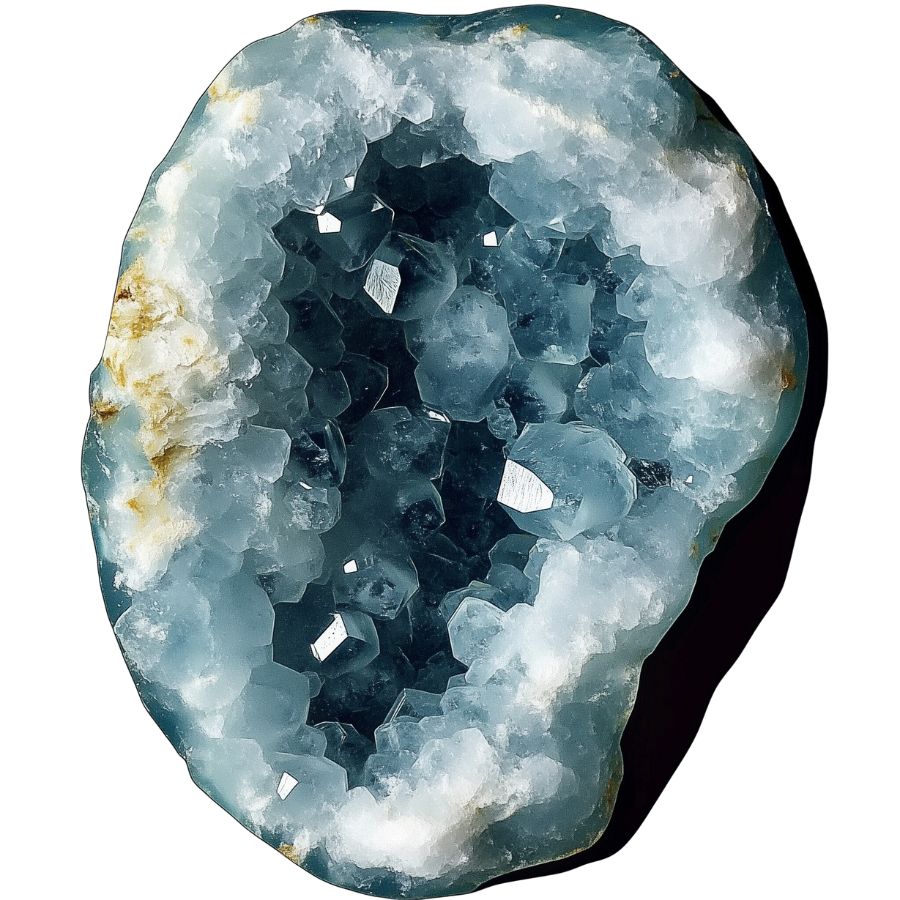
Celestite geodes are like pieces of sky trapped in rock. Their crystals are typically a delicate blue, ranging from almost colorless to deep sky blue. In rare cases, celestite can form in other colors. Pink celestite is highly prized by collectors.
One unique feature of celestite is its perfect cleavage. This means the crystals can be easily split into rhombohedral shapes.
These geodes form in a unique way. They start as nodules of a soft mineral called alabaster. Over time, this dissolves and is replaced by celestite crystals. Some celestite geodes are huge, like the famous Crystal Cave in Ohio.
Celestite isn’t just pretty to look at. It’s used to make strontium, an element with many uses. You’ll find strontium in fireworks, where it creates red colors. It’s also used in making TV screens and ceramics.
Jasper Geode
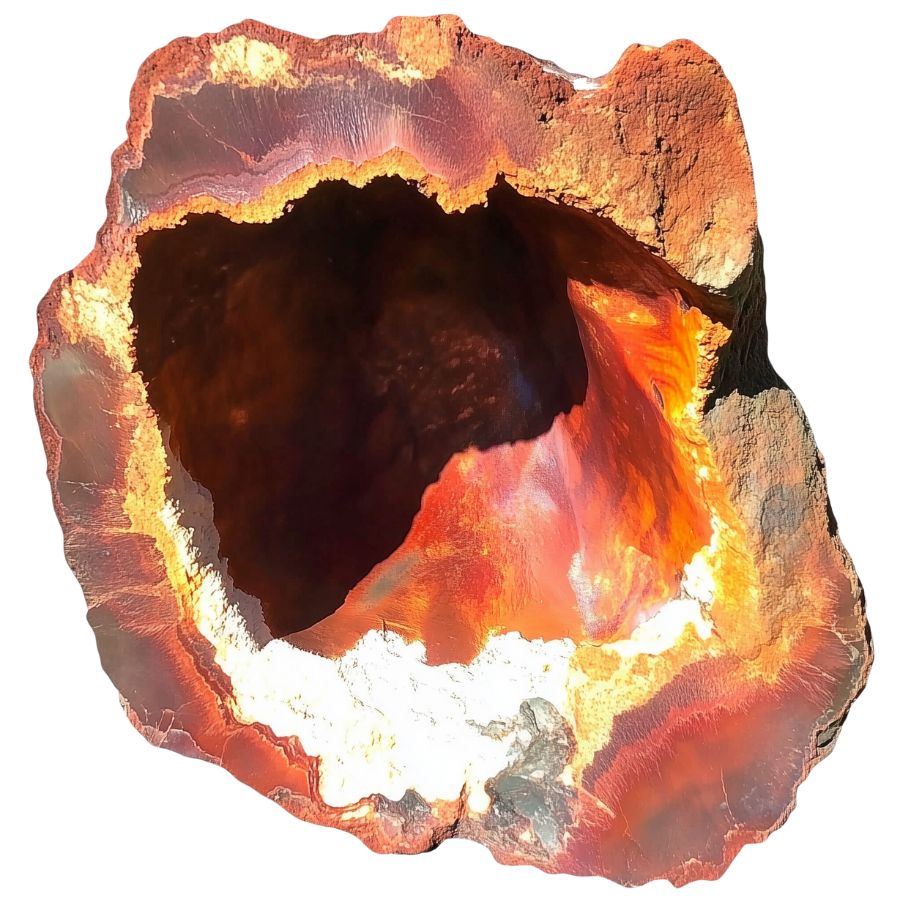
Jasper geodes are the chameleons of the mineral world. They can appear in almost any color, often with multiple hues in a single specimen. Patterns can range from solid colors to intricate swirls, bands, or spots.
One fascinating type is picture jasper. These geodes contain patterns that resemble landscapes, with “skies,” “mountains,” and “rivers” visible in the stone. Each one is like a miniature painting created by nature.
Some jasper geodes contain orbicular patterns – spherical structures that formed as the jasper solidified. These create eye-catching bull’s-eye or flower-like designs in the stone, making each piece truly one-of-a-kind.
Carnelian Geode
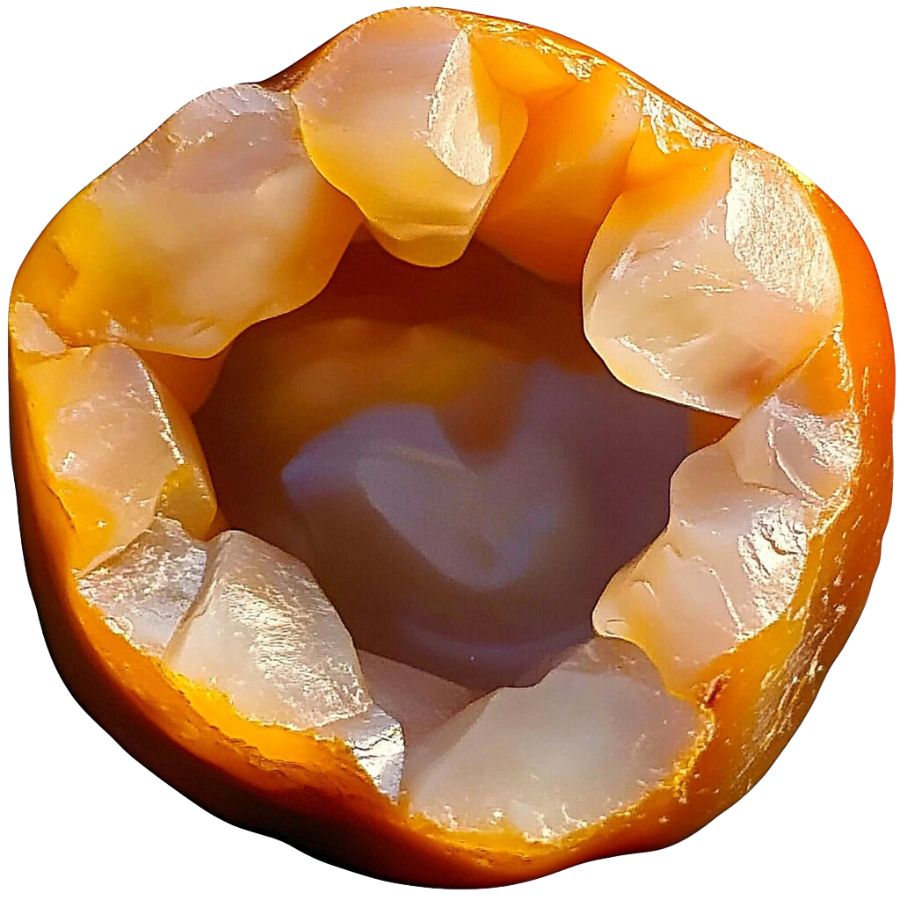
Carnelian geodes have vibrant orange to reddish-brown colors. They can be somewhat see-through, which makes them look even more interesting. The bright colors come from the iron in the stone.
These geodes stand out from other similar stones. They’re brighter than sard, which is usually darker and more brownish. And unlike agate, carnelian doesn’t have bands or stripes.
Carnelian has been popular for a long time. Ancient Egyptians and Greeks used it to make special rings. It’s tough enough for everyday jewelry.
Some people heat or dye carnelian to make its color even brighter. This makes it a favorite for both rock collectors and jewelry lovers.
Fluorite Geode
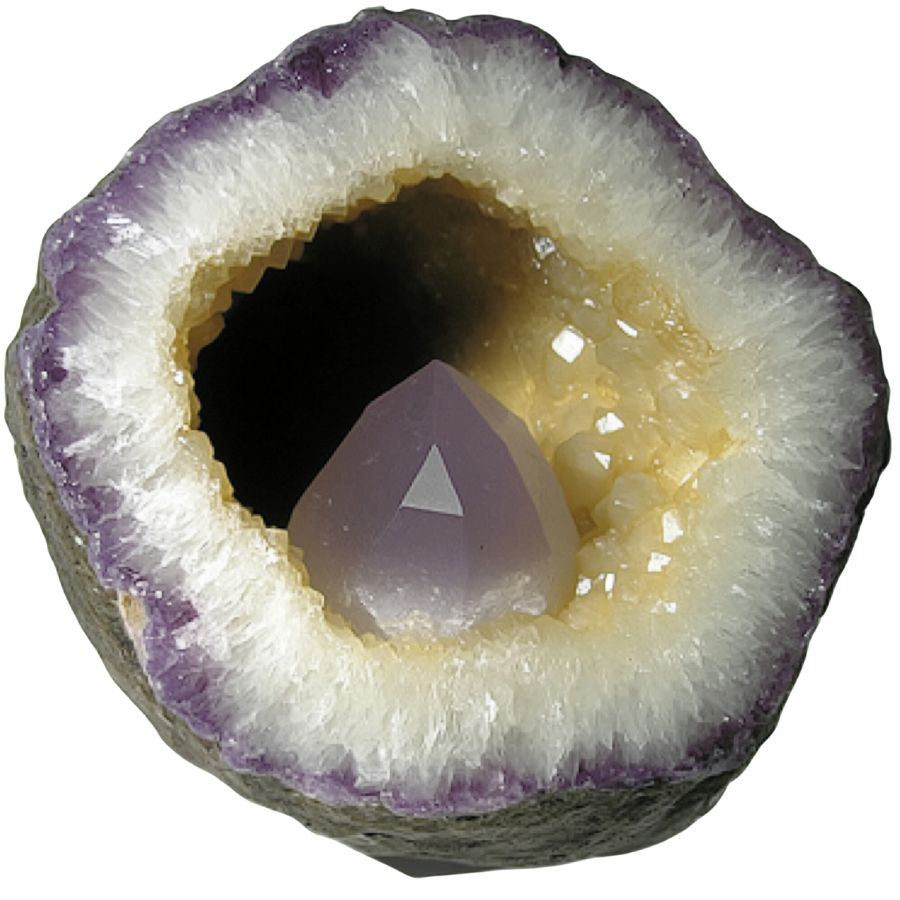
Fluorite geodes are like nature’s rainbow. They come in many colors – purple, green, blue, yellow, and sometimes even clear or black. When you open one up, you might see cube-shaped or eight-sided crystals inside.
What makes fluorite special is that you can often see more than one color in a single stone. This is different from many other geodes. Also, fluorite has a unique way of splitting when it breaks.
A cool fact: fluorite glows blue under ultraviolet light. This was first discovered back in 1852. Because of its many colors and this glowing ability, fluorite is sometimes called the “most colorful mineral in the world.”
Scolecite Geode
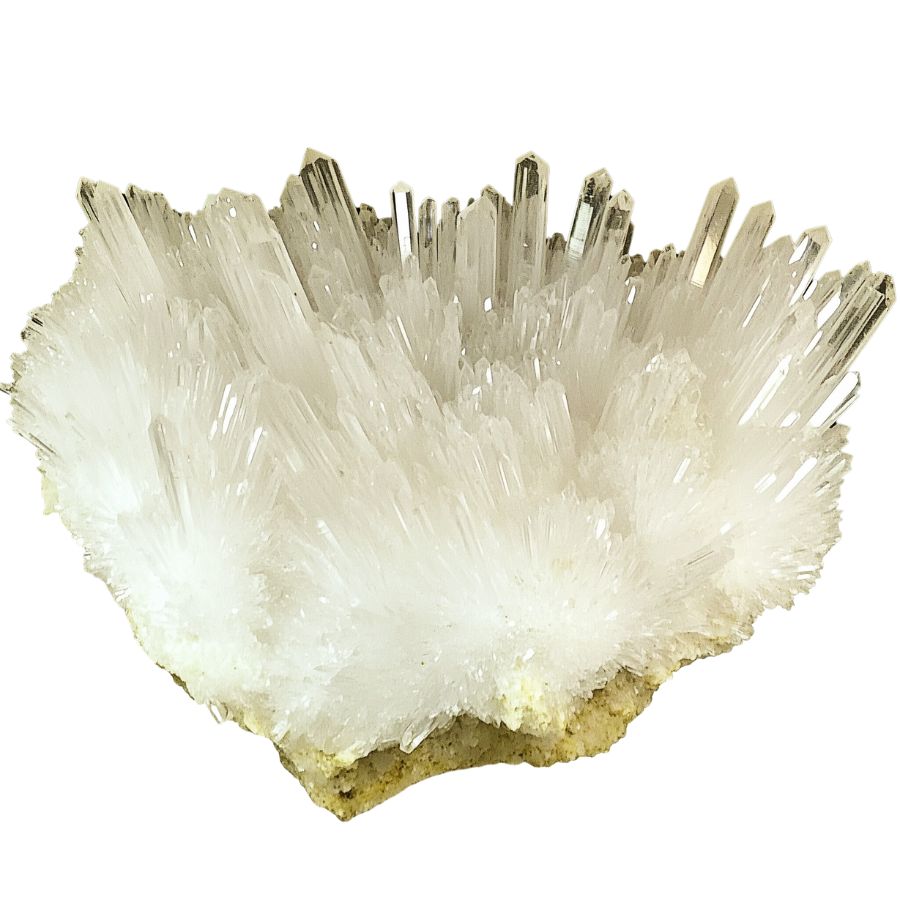
Scolecite geodes are like tiny crystal caves. They’re usually white or colorless, but sometimes you might find pink, yellow, or green ones.
What makes them special is the crystals inside. They look like thin needles or delicate hairs, all pointing out from the center.
These geodes are different from others because of their crystal shape. Instead of blocky or chunky crystals, scolecite has these fine, hair-like ones. This gives them a unique, delicate look.
Scolecite has an interesting property – it can hold a lot of water in its structure. This means it can absorb and release water easily. This makes scolecite useful in various ways, not just as a pretty rock to look at.
Apophyllite Geode
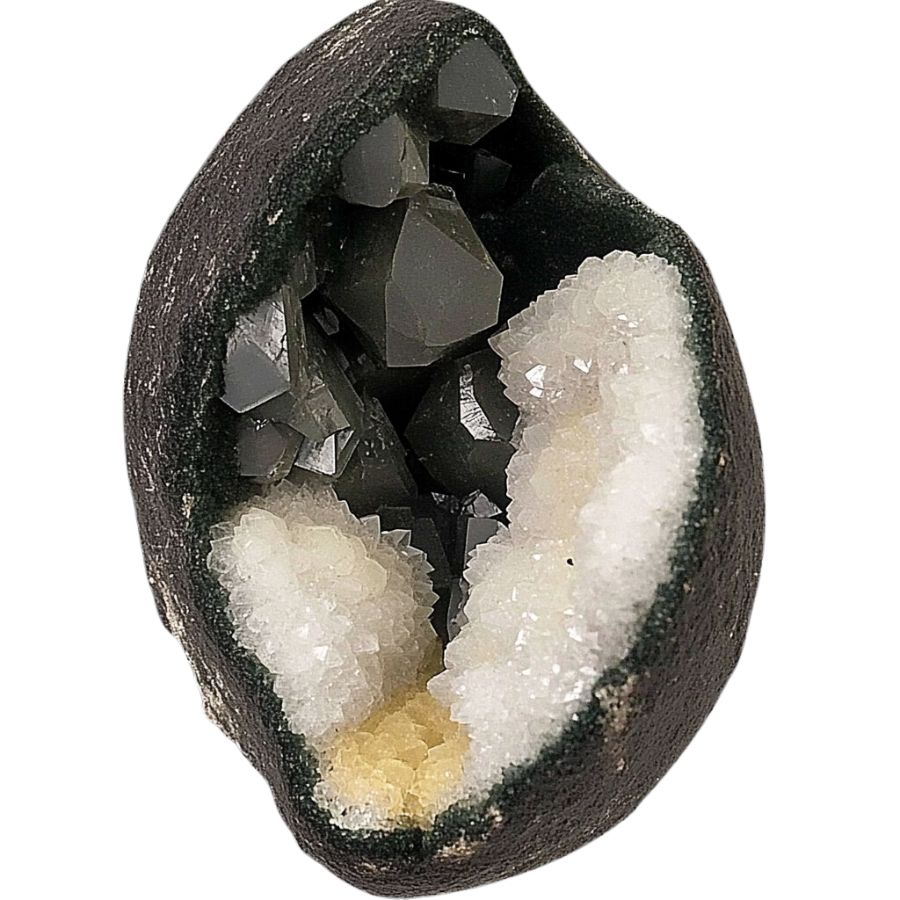
Apophyllite geodes are like nature’s disco balls. They often have dark or black crystals inside a hollow rock. These crystals can be see-through or slightly cloudy, with cube-like or flat shapes.
What makes apophyllite geodes stand out is how the crystals form. They grow in round clusters that look like tiny disco balls. This unique formation is rare and makes them special to rock enthusiasts.
Collectors really prize these “disco ball” clusters. They’re not common, which makes them valuable to people who love unusual rocks. The way apophyllite crystals catch and reflect light adds to their appeal, making them fascinating to look at and study.
What Rough Geode Looks Like
Identifying a rough geode might seem tricky, but with a few tips, you can spot one even if you’re not a rock expert. Here’s how you can do it.
Look for a Rounded Shape
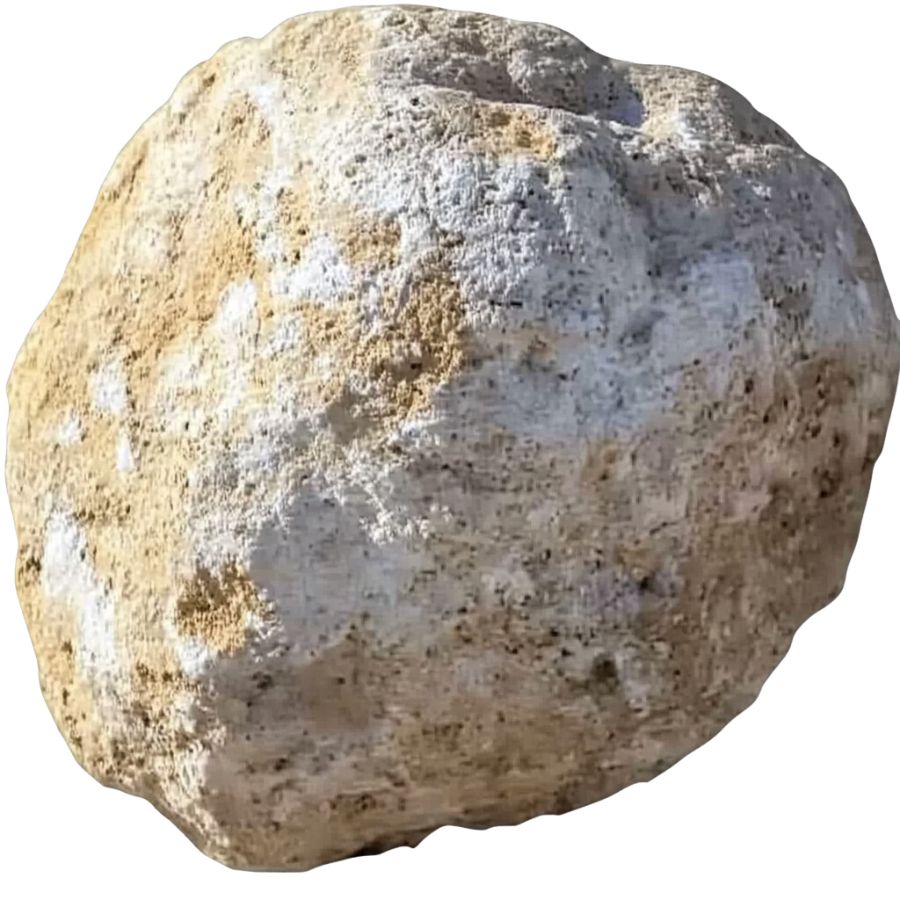
A rough geode often has a rounded or egg-like shape. It might not be perfectly round but look for a generally bulbous form.
When you’re out searching, skip the flat, jagged rocks. Geodes usually have smoother exteriors because they’ve been rolling around in rivers or other environments for a long time.
Check for a Dull, Bumpy Surface
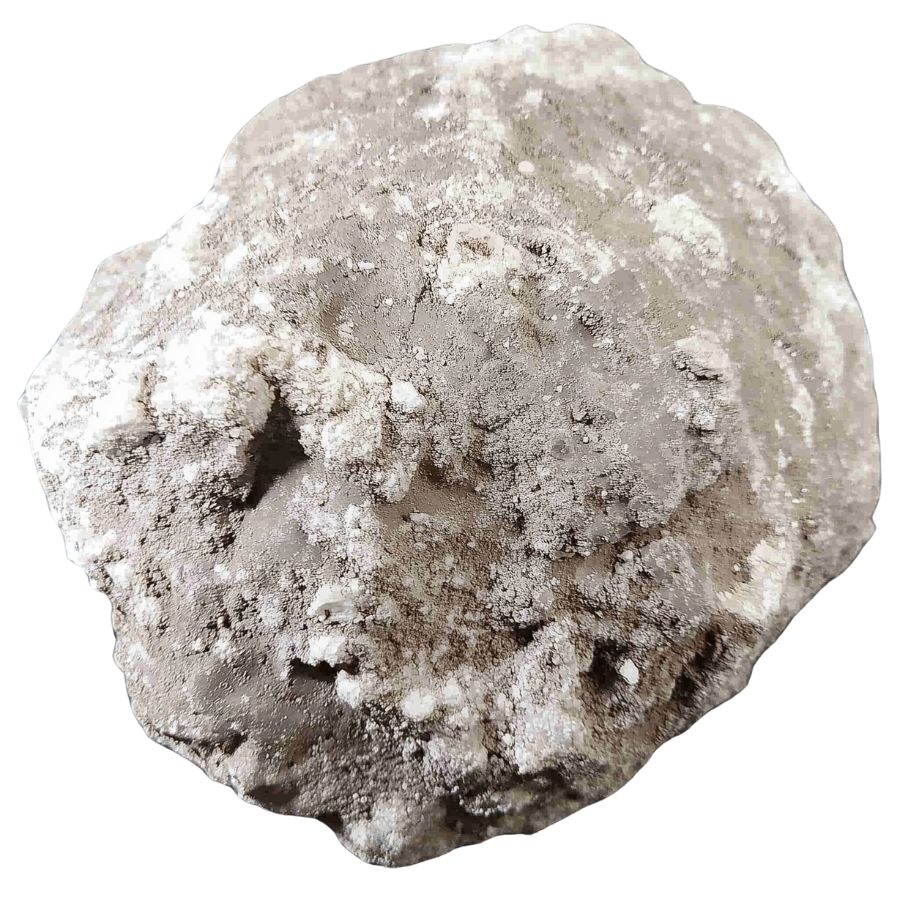
The outside of a geode isn’t usually shiny. Instead, it’s dull, bumpy, and a bit rough.
Imagine a potato or a clump of dirt with some bumps and dents. That’s how a geode might look before it’s cracked open.
The outside won’t give away much of what’s inside, so don’t be fooled by its ordinary appearance.
Test the Weight
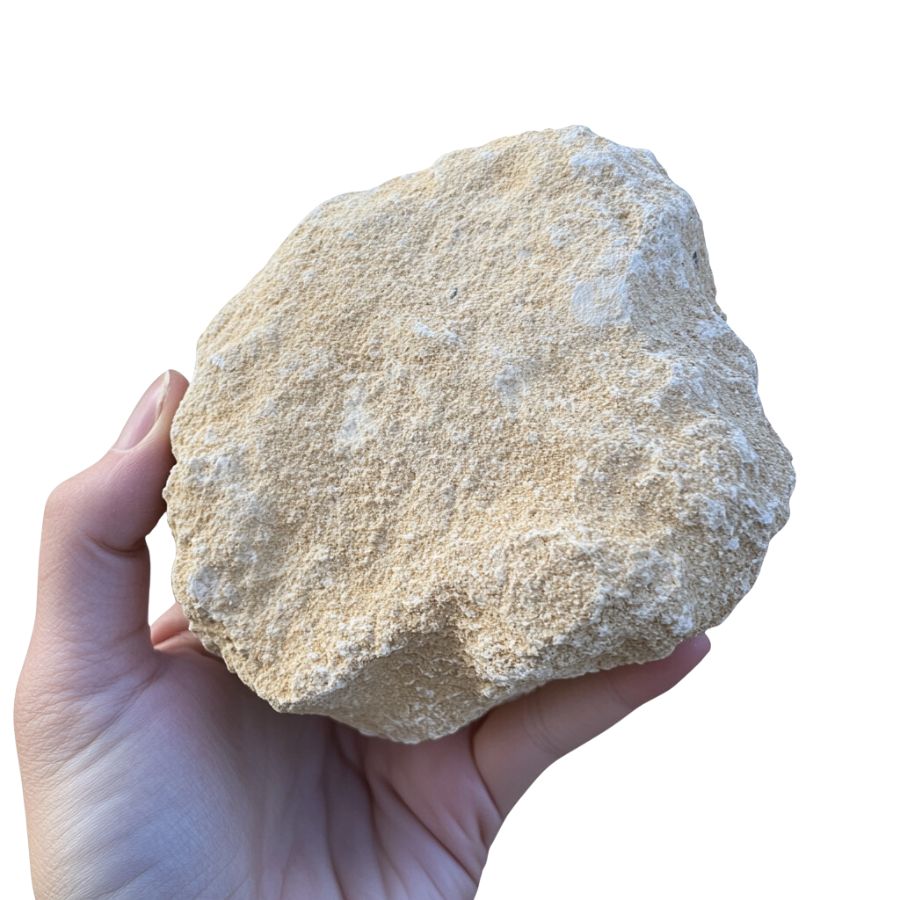
Pick up the rock. Does it feel lighter than it looks? That’s a good sign!
Geodes are hollow or partially hollow, which makes them lighter than solid rocks of the same size. If it feels unexpectedly light, you might have found something special.
Look for Tiny Crystals or Mineral Patches
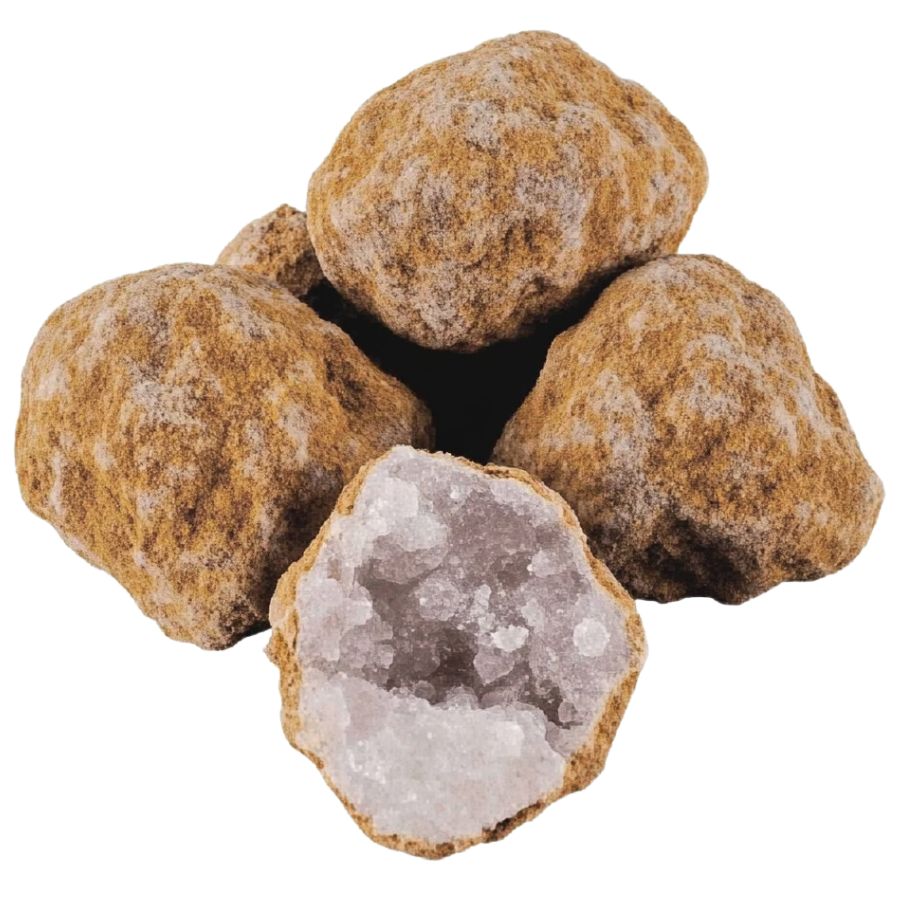
Sometimes, you can spot small crystals or mineral deposits on the outside. These could look like tiny sparkles or specks of color.
While the outside of a geode is usually dull, a little peek of what’s inside might show through. Keep an eye out for these hints, especially if you’re in a known geode-rich area.
Tips on Where to Look
Once you get to the places we have listed below there are some things you should keep in mind when you’re searching:
Explore Riverbeds and Streams
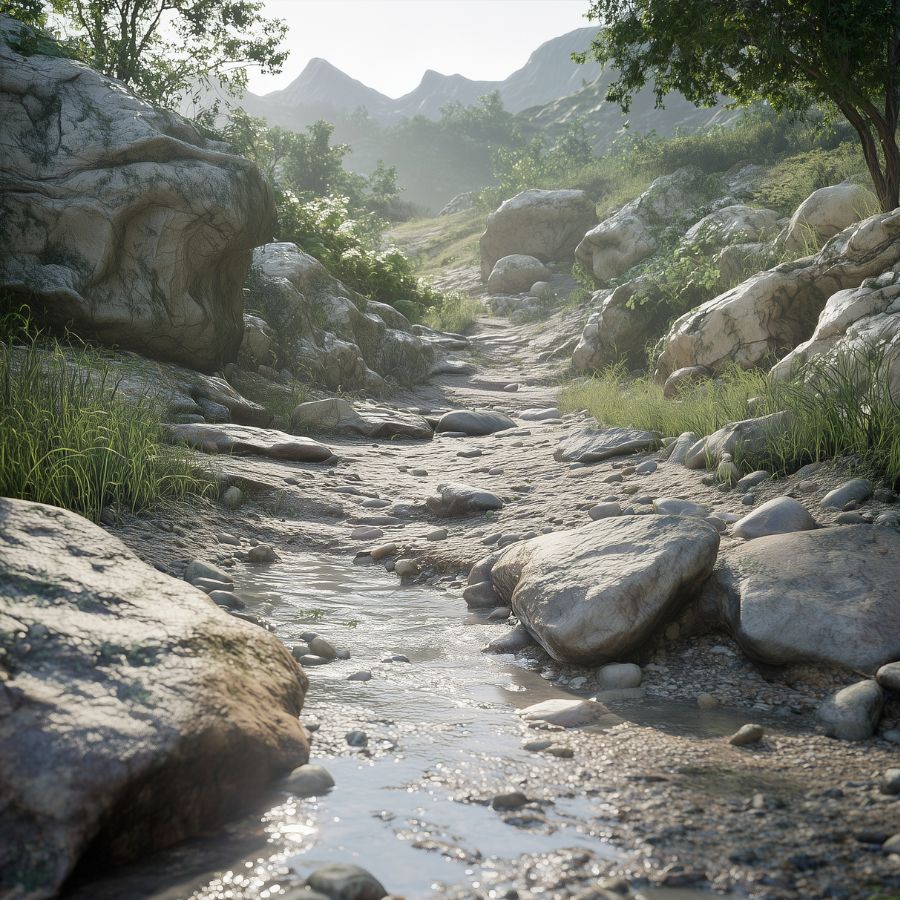
Geodes often form in riverbeds or streams. Water flow smooths out their rough edges and deposits them in these areas.
When exploring, focus on gravel bars or the edges of rivers where rocks naturally gather.
Search in Sedimentary Rock Layers
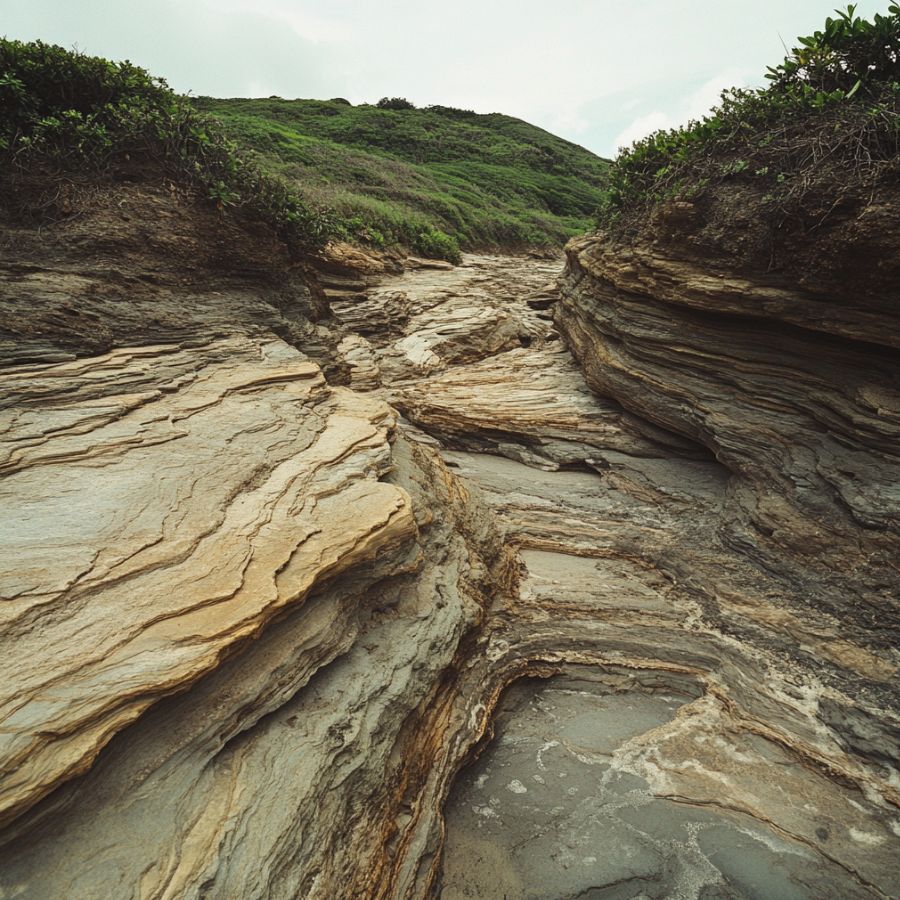
Sedimentary rocks, like limestone, are prime spots for geodes. These rocks form in layers over time, trapping minerals inside.
Look for areas where sedimentary rocks are exposed, such as cliffs or road cuts.
Visit Old Mines or Quarries
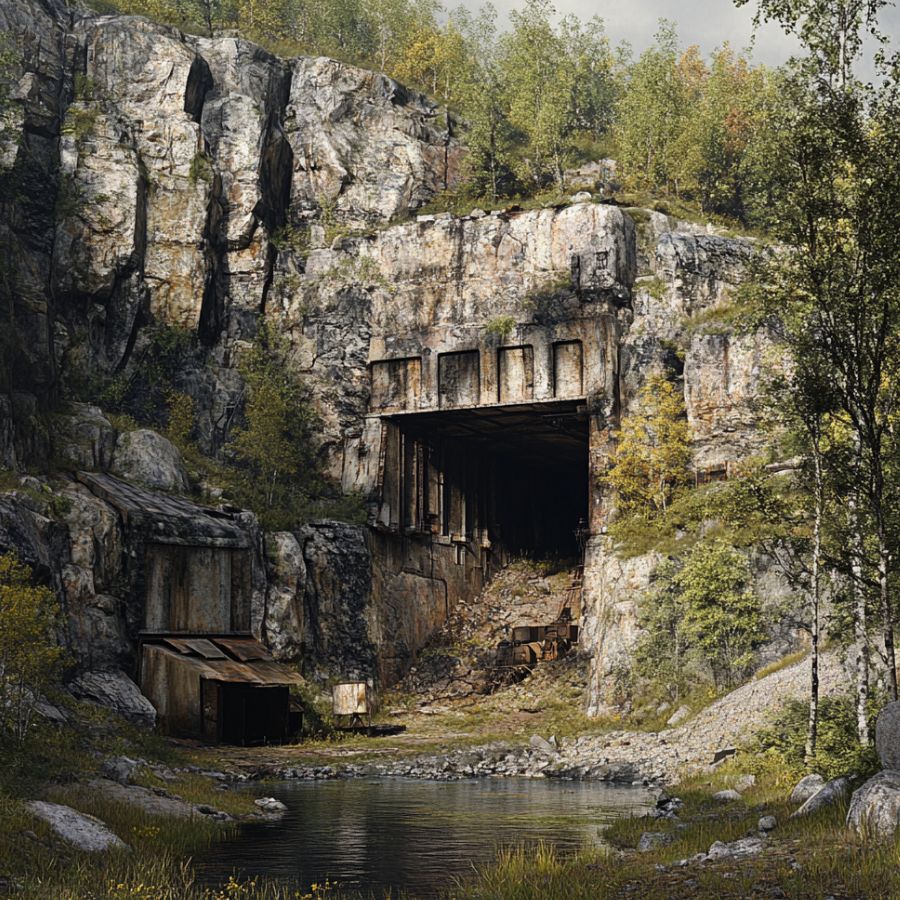
Abandoned mines and quarries are excellent spots for geode hunting.
Workers often missed geodes while digging for other materials. Explore the tailings or leftover rock piles for hidden treasures.
Explore Hills and Rock Outcrops
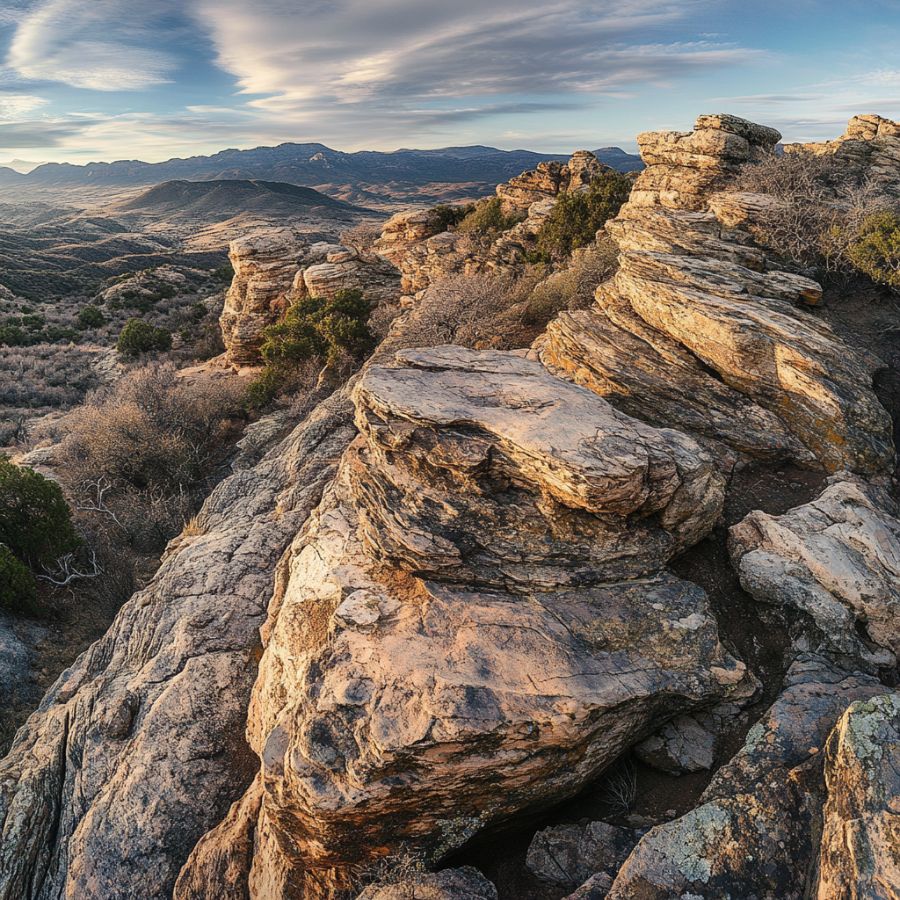
Hills and rocky outcrops often reveal geodes. As erosion wears away the softer rock, it exposes the harder geodes.
Look for areas with exposed rocks and keep an eye out for rounded shapes.
The Types of Geodes You Can Find in Texas
Geodes come in various types and are found all over the world. The appearance and price of a geode are influenced by the kind of crystal inside it. You can find the following in Texas:
- Agate geodes
- Amber geodes
- Barite geodes
- Blue Topaz geodes
- Calcite geodes
- Celestite geodes
- Chalcedony geodes
- Jasper geodes
- Quartz geodes
The Best Places To Find Geodes in Texas
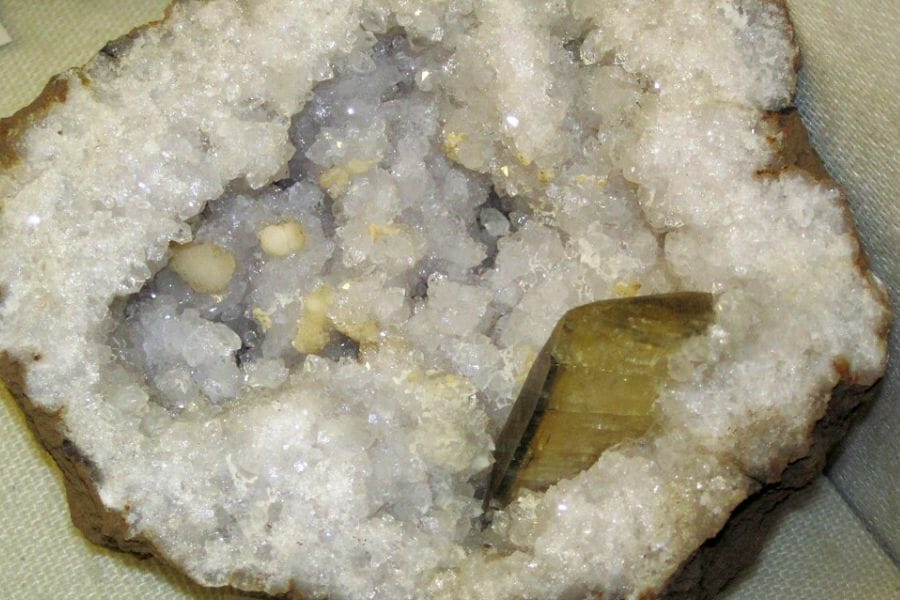
We’ll begin by enumerating our absolute favorite locations to discover geodes in Texas. There are many fantastic locations for gem mining in Texas, but only a few are ideal for what we’re looking for. Even though some of these locations are not widely known, they have regularly provided us with excellent selections when we’re looking.
Always Confirm Access and Collection Rules!
Before heading out to any of the locations on our list you need to confirm access requirements and collection rules for both public and private locations directly with the location. We haven’t personally verified every location and the access requirements and collection rules often change without notice.
Many of the locations we mention will not allow collecting but are still great places for those who love to find beautiful rocks and minerals in the wild without keeping them. We also can’t guarantee you will find anything in these locations since they are constantly changing.
Always get updated information directly from the source ahead of time to ensure responsible rockhounding. If you want even more current options it’s always a good idea to contact local rock and mineral clubs and groups
Brewster County
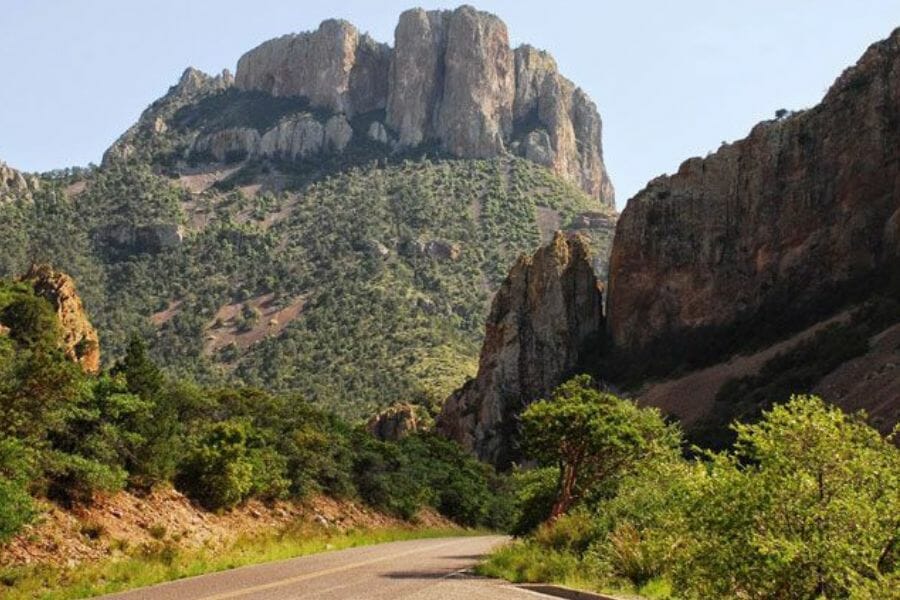
Brewster County is located in the far western corner of Texas, bordered by New Mexico and Mexico. It’s a sprawling county, with an area of 6,208 square miles – that’s almost the same size as Connecticut! It’s terrain is mostly desert-like and mountainous. Geologically, Brewster County is part of the Basin and Range Province. Alternating mountain ranges and valleys characterize this province, created millions of years ago by tectonic activity.
The main rock types in Brewster County are limestone and shale, which are thought to have been deposited during the Permian period. With its rugged terrain and dry climate, Brewster County is a popular destination for outdoor enthusiasts looking to explore the great outdoors!
Remember that it’s always important to know the state’s updated guidelines on collecting and hunting rocks before doing these activities.
Where we found geodes in Brewster County
Geodes can be found in many places in Brewster County, Texas, along the Rio Grande banks, and in areas with exposed limestone. They can also be found in dry river beds, gravel pits, quarries, and road cuts.
- In the Alpine area, 6 miles southwest on US90 to RR water tank, beyond the tank of the valley.
- Banks and beds of Terlingua creek.
- In the Big Bend area.
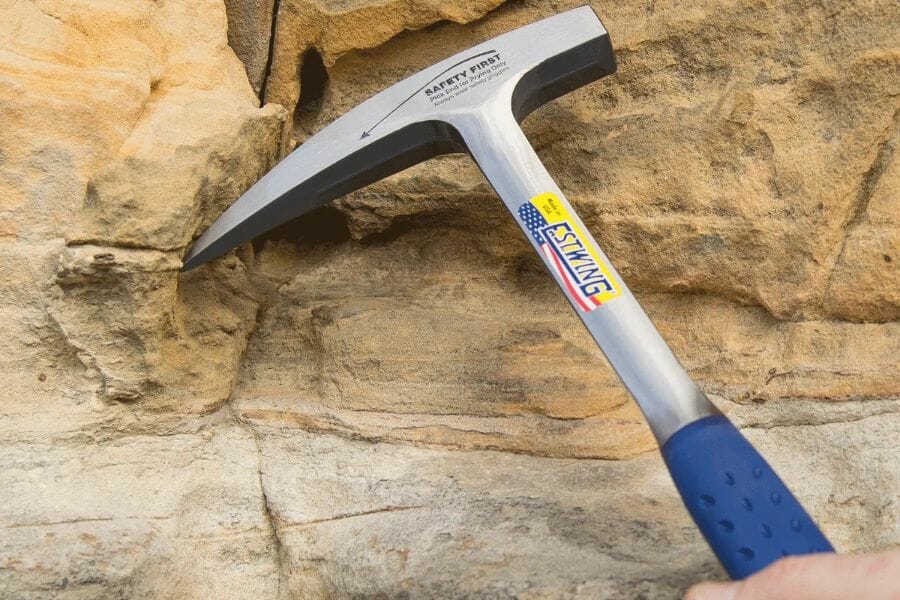
The tools every geode hunter will need
When you're out looking for geodes having the right tools for the job is very important. You don't need a lot for most trips but there are a handful that are critical and will make your life a lot easier.
We get asked a lot about the equipment we use. Over the years we've found a handful of tools that we recommend to both new and experienced geode hunters which we outline in great detail in our complete rockhounding tools and kit guide. These are quality options that also happen to be relatively inexpensive.
Below are the basic tools that make your life so much easier and save you a ton of time. Check out the full guide to see everything we recommend bringing. One quick note, as an Amazon Associate I earn from qualifying purchases but we try very hard to only recommend gear we would use ourselves and often recommend brands you can't find on Amazon.
At a minimum you should have:
1 - Sturdy rock hammer: The Estwing Rock Pick is our standard
2 - Rugged chisels: Try Kendo' 3-piece Chisel Set
3 - Compact shovel: The Koleiya 28-inch shovel works well
4 - Rock screen pan: The Wazakura Soil Sieve Set fits the bill
5 - Eye protection: DeWalt Safety Glasses are cheap and comfortable
6 - Head protection: Malta's Safety Helmet has been our go-to
7 - Jewelers lens with at least 20x magnification: Jarlink's Jewelers Loop is perfect
The geode-finding books that we use most
There are also a few books that have been extremely helpful in the search for gems. These books have great recommendations and tips:
National Audubon Society Field Guide to Rocks and Minerals: North America
Southwest Treasure Hunter's Gem & Mineral Guide
Earth Treasures: The Southwestern Quadrant
We provide links to find these tools on Amazon but some can also be found at your local hardware stores. For more recommendations check out the link to our full tool guide above.
Culberson County
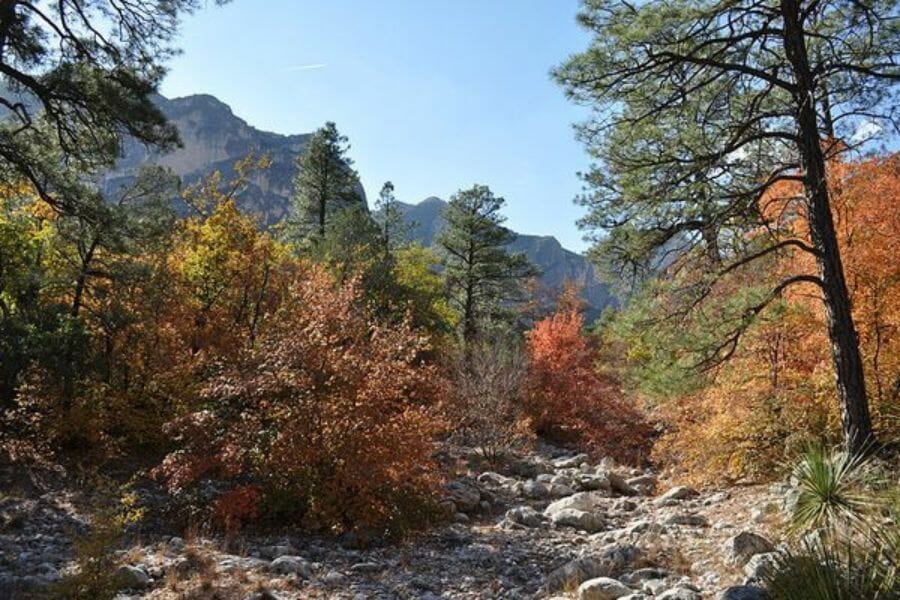
Culberson County is a rugged, rural landscape full of history and culture. With its expansive desert terrain and rolling hills, it’s a great place to explore on foot or by horseback. From its vast ranches to charming small towns like Van Horn, there’s plenty to see and do.
The area has been inhabited for centuries by Native American tribes such as the Mescalero Apache and Comanche. Today, Culberson County is home to a diverse population of ranchers, farmers, retirees, and other folks who make the county their home.
Where we found geodes in Culberson County
- Geodes can be found in the limestone outcrops of the county.
- Van Horn area
- Seven Hearts Gap area
Hudspeth County
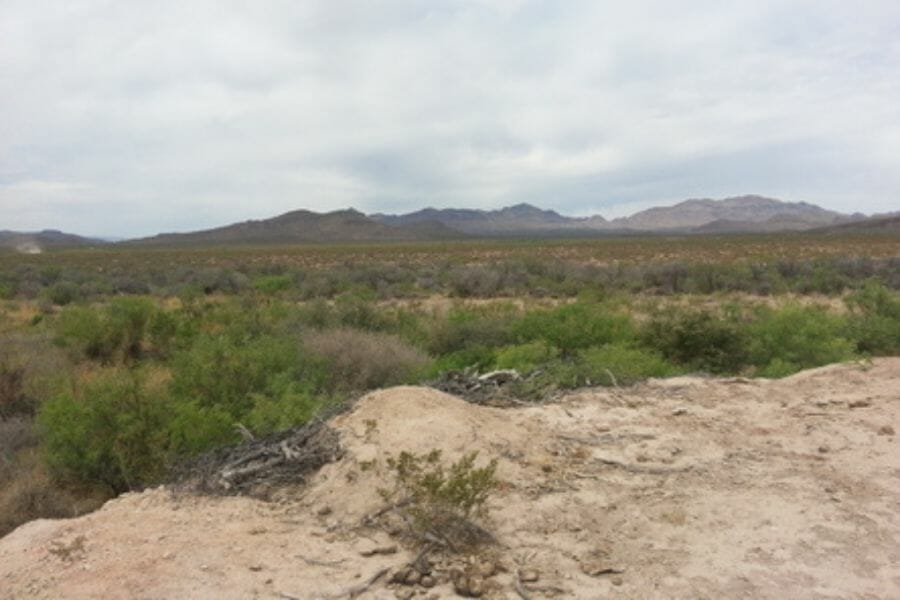
Hudspeth County, in far West Texas, is a land of contrasts. Its vast desert terrain is dotted with rugged mountains and canyons, while the Rio Grande River runs along its southern border. The county is composed of sedimentary rocks from the Paleozoic Era. Its topography ranges from flat plains to high peaks and deep canyons. In between are rolling hills, mesas, and badlands. The soil is mostly sandy or clay-based and prone to erosion.
The area’s climate ranges from hot summers to cold winters, with occasional snowfall in the higher elevations. It’s a dry place – drought is a common occurrence – but it’s also home to several species of cacti, yucca plants, and other desert succulents that thrive in this harsh environment. Despite its remote location and challenging terrain, Hudspeth County has plenty of outdoor opportunities for those willing to explore its wild beauty.
Where we found geodes in Hudspeth County
- Near the Mexican border
- Sierra Blanca area
- Southern face of the Quitman Mountains
Little Lucy Creek
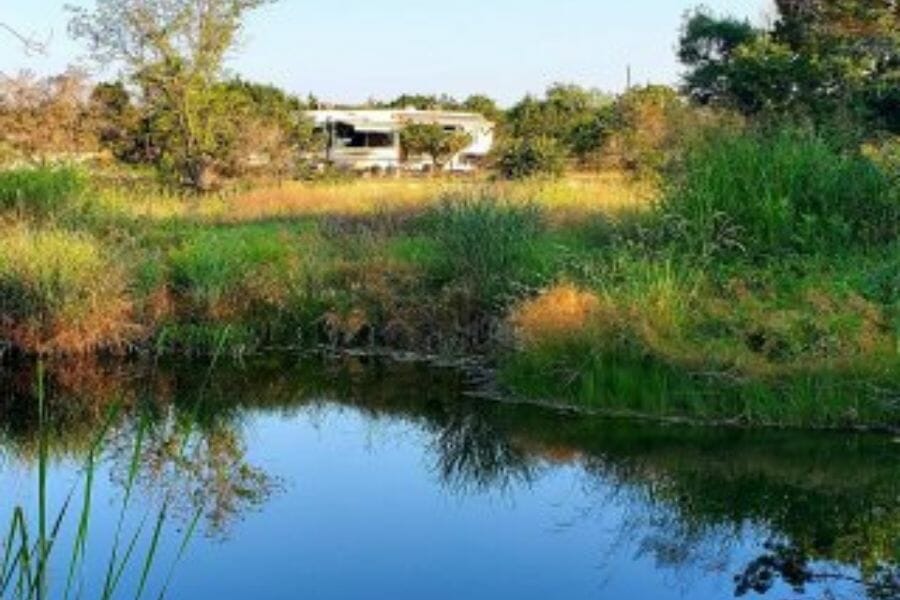
Little Lucy Creek is a scenic spot tucked away in the Texas Hill Country. It’s a hidden gem, with its rolling hills, lush vegetation, and tranquil waters. The terrain varies and includes rocky outcroppings, grassy meadows, and wooded areas.
Geologically speaking, the creek is fed by underground springs that emerge from limestone bedrock. Little Lucy Creek is an idyllic spot for hunting geodes and simply taking in some of Mother Nature’s beauty.
Where we found geodes at Little Lucy Creek
You can search by the creek bed and banks for sedimentary rocks containing geodes. You can also search the nearby hills and outcroppings to locate geodes.
Rio Grande River gravel beds
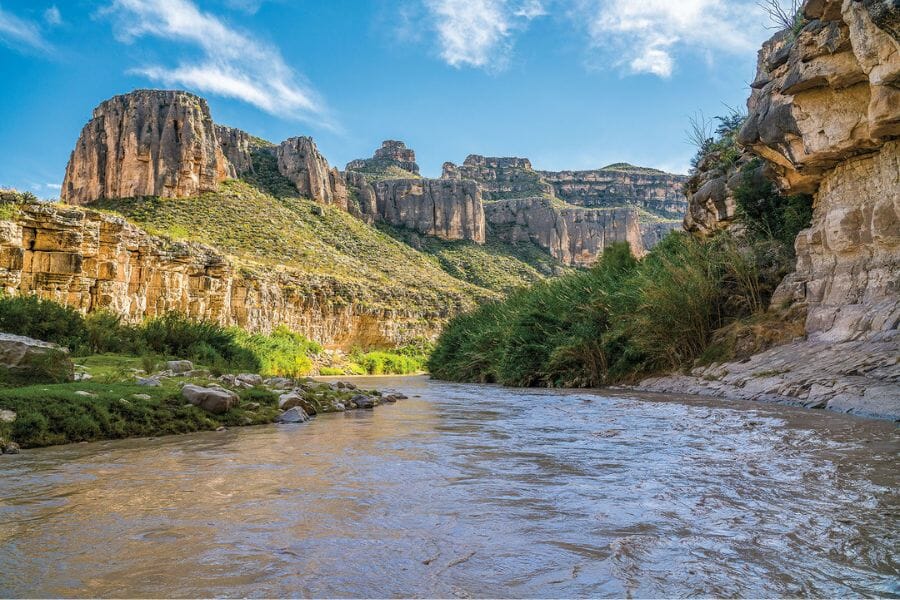
The Rio Grande, or Rio Bravo as it’s known south of the border, is a river of many faces. It winds through the Lone Star State of Texas, forming a natural border between Mexico and the US. With its diverse geography, terrain, and geology, the Rio Grande provides a unique landscape for travelers.
The Rio Grande begins in Colorado and flows southward for 1,885 miles before emptying into the Gulf of Mexico at Brownsville. The terrain along its course is varied – filled with rolling hills and canyons to flatlands and desert – while geology ranges from limestone formations to sandstone bluffs. This diversity of landscapes contributes to the river’s beauty, making it a popular destination for outdoor enthusiasts seeking adventure.
Where we found geodes at the Rio Grande River
Geodes can sometimes be found along the banks of the river and its gravel beds. They are also commonly found in sedimentary rock formations, such as limestone and sandstone, deposited by the river over millions of years.
Other Great Places To Dig For Texas Geodes
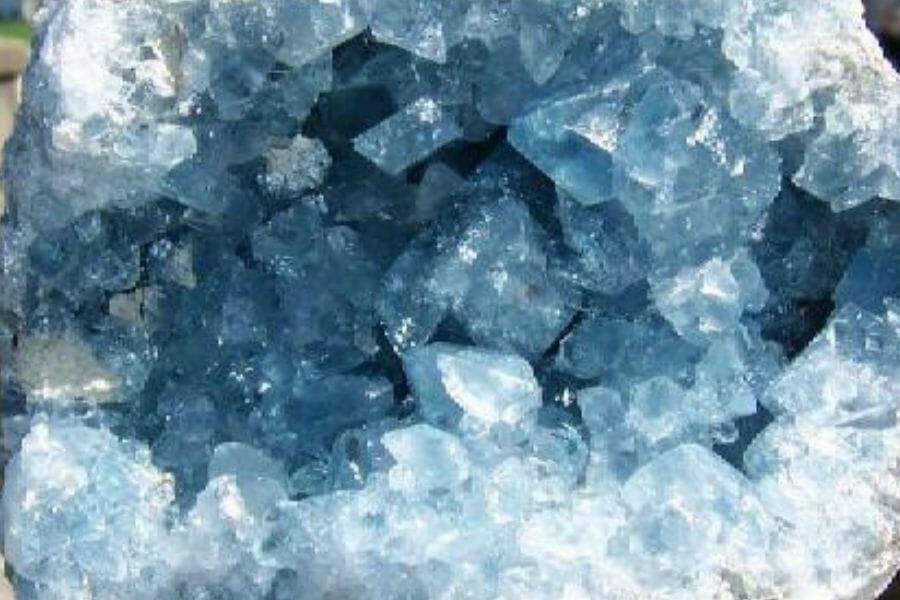
We wanted to share the rest of our top picks now that we’ve given you our favorites. We listed our suggestions by the county before moving on to more general areas where we’ve had great success locating geodes. We’ll offer more detailed recommendations in the next section for any recommendation that we refer to as “county wide”.
Our recommendations by county
| County | Location |
| Brewster | In Alpine area, travel 6 miles southwest on US 90 to the RR water tank, which is past the valley’s tank. |
| Brewster | Big Bend area |
| Brewster | Banks and beds of Terlingua creek |
| Cameron | Rio Grande River gravel beds |
| Culberson | Van Horn area |
| Culberson | Seven Hearts Gap area |
| Edwards | Edwards Plateau |
| Hudspeth | Near the Mexican border |
| Hudspeth | Sierra Blanca area |
| Hudspeth | Southern face of the Quitman Mountains |
| Lampasas | In Lampasas area, upstream and down along Little Lucy Creek |
| Real | In the Leakey area, proceed south about half a mile downhill, close to the Horsecollar Roadside Park to reach the steep bank on the west. |
| Travis | West lake hills area at Mt. Bonell |
Common Geode-Hunting Questions
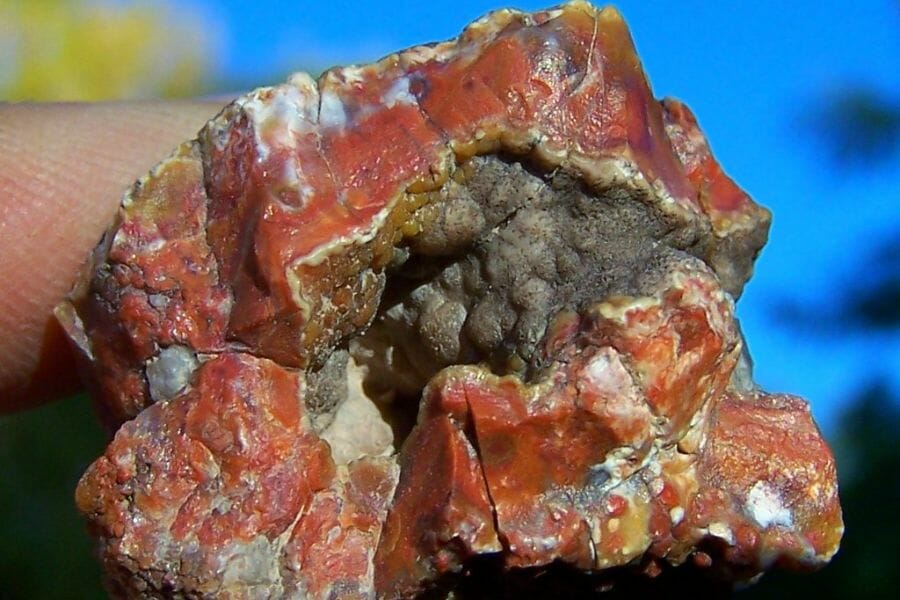
It’s important to answer certain generally asked questions concerning geodes from Texas.
Where can you find amethyst geodes in Texas?
Amethyst geodes can’t be found at natural locations in the state, but these are available to purchase in many of the rock and mineral shops throughout Texas. You can also search for mineral shows in your area to find vendors who may sell amethyst geodes.
Is it illegal to collect geodes in Texas?
Geode collecting is legal in Texas if you abide by local collecting regulations. Just ensure you’re following applicable local laws, and if you’re on private property, make sure you have permission to collect.
The Best Places To Buy Geodes In Texas
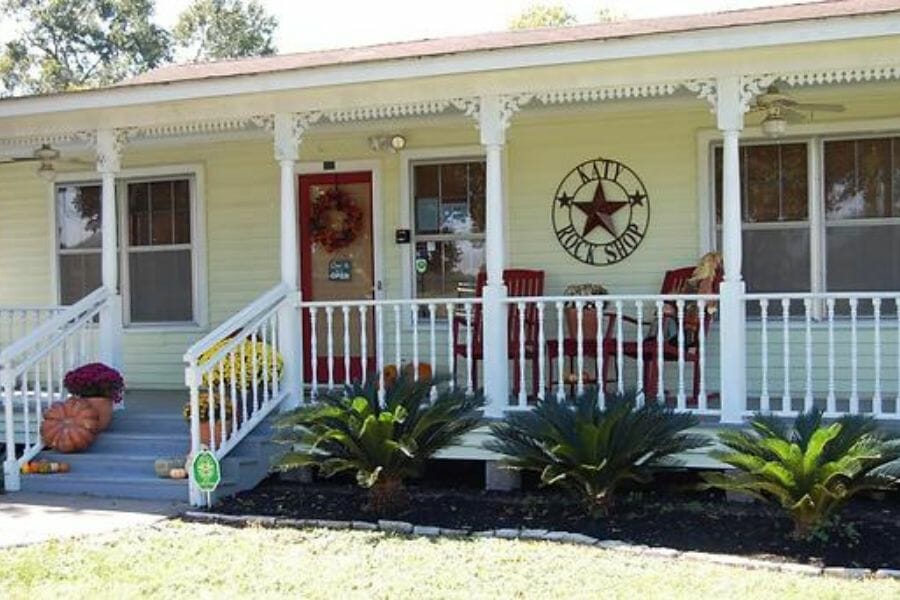
Not everyone enjoys long hikes through the bushes in search of geodes. Sometimes all you want is something lovely to add to your collection or to place on your desk.
Here are some additional places where you can purchase incredibly amazing geodes in your area that we like:
- Enchanted Rocks and Jewelry – 805 Berry St, Llano, TX 78643, United States
- Amazon – It’s surprising that Amazon offers a good variety of geodes. For those who prefer to do it themselves, there are even complete kits containing geodes to crack open.
- Katy Rock Shop – 535 Pin Oak Rd, Katy, TX 77494, United States
- Nature’s Gallery – 1102 S Elm St Ste 102, Carrollton, TX 75006, United States
- Old Wizard’s Rock Shop – 14005 African Hill Rd, Willis, TX 77378, United States
- Rock and Fossil Deposit – 16111 San Pedro Ave Suite 103, Hollywood Park, TX 78232, United States
Additional places to find geodes in nearby states
Check out our guides for nearby states if you’ve already tried all of our suggestions above or if you’re planning a trip outside of the state:
If you have any recommendations for our list, please leave a comment below!

